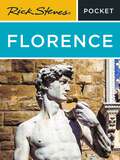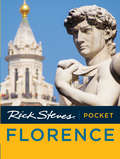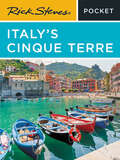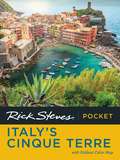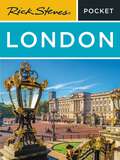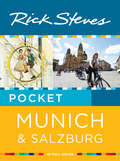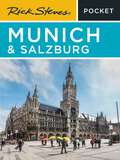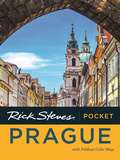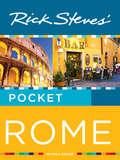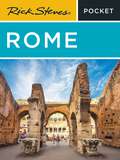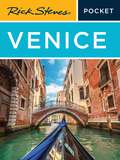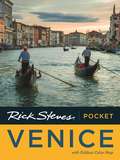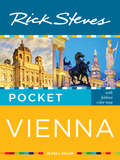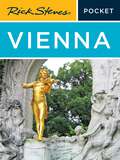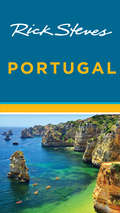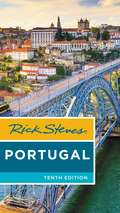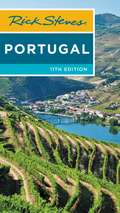- Table View
- List View
Rick Steves Pocket Florence
by Rick StevesMake the most of every day and every dollar with Rick Steves! This colorful, compact guidebook is perfect for spending a week or less in Florence:City walks and tours: Five detailed tours and walks showcase Florence's essential sights, including the Uffizi Gallery, the Duomo, and Michelangelo's David at the Accademia, plus specific recommendations for each neighborhood Rick's strategic advice on what's worth your time and money What to eat and where to stay: Sample artisanal gelato, chat with locals over a glass of Chianti, and enjoy the Old-World ambience of a Florentine bed and breakfast Day-by-day itineraries to help you prioritize your time A detailed, detachable fold-out map, plus museum and city maps throughout Full-color, portable, and slim for exploring on the goTrip-planning practicalities like when to go, how to get around, basic Italian phrases, and more Lightweight yet packed with information on what to do and see, Rick Steves Pocket Florence truly is a tour guide in your pocket. Spending more time in the region? Try Rick Steves Florence & Tuscany.
Rick Steves Pocket Florence (Rick Steves)
by Rick Steves Gene OpenshawRick Steves' Pocket guidebooks truly are a "tour guide in your pocket.” Each colorful compact 280-page book includes Rick's advice for prioritizing your time, whether you're spending 1 or 7 days in a city. Everything a busy traveler needs is easy to access: a neighborhood overview, city walks and tours, sights, handy food and accommodations charts, an appendix packed with information on trip planning and practicalities, and a fold-out city map.Rick Steves' Pocket Florence includes the following walks and tours: Renaissance Walk Accademia Tour: Michelangelo's David Uffizi Gallery Tour Bargello Tour Duomo Museum Tour
Rick Steves Pocket Italy's Cinque Terre
by Rick Steves Gene OpenshawMake the most of every day and every dollar with Rick Steves! This colorful, compact guidebook is perfect for spending a week or less in Italy's Cinque Terre: City walks and tours: Six detailed tours and walks showcase the essential sights of each village, including Monterosso al Mare, Vernazza, Riomaggiore, and more Rick's strategic advice on which experiences are worth your time and money What to eat and where to stay: Enjoy local wine and seafood antipasti, chat with locals at a family-run trattoria, and admire views of the ocean from your hotel Day-by-day itineraries to help you prioritize your time A detailed, detachable fold-out map, plus individual village maps throughout Full-color, portable, and slim for exploring on the go Trip-planning practicalities like when to go, how to get around, and more Lightweight yet packed with valuable insight into the history and culture of Italy, Rick Steves Pocket Italy's Cinque Terre truly is a tour guide in your pocket. Expanding your trip? Try Rick Steves Italy!
Rick Steves Pocket Italy's Cinque Terre (Rick Steves)
by Rick StevesRick Steves Pocket guidebooks truly are a "tour guide in your pocket." This colorful, compact 220-page book includes Rick's advice for prioritizing your time, whether you're spending 1 or 7 days in a city. Everything a busy traveler needs is easy to access: a neighborhood overview, city walks and tours, sights, handy food and accommodations charts, an appendix packed with information on trip planning and practicalities, and a fold-out city map.
Rick Steves Pocket London (Rick Steves Ser.)
by Rick StevesMake the most of every day and every dollar with Rick Steves! This colorful, compact guidebook is perfect for spending a week or less in London: City walks and tours: Six detailed tours and walks showcase London's essential sights, including the National Gallery, the Tower of London, and Westminster Abbey, plus handy neighborhood breakdowns Rick's strategic advice on what experiences are worth your time and money What to eat and where to stay: Dig into hearty pub fare with the locals, wash down a classic fish n' chips with a pint, and linger over high tea Day-by-day itineraries to help you prioritize your time A detailed, detachable fold-out map, plus museum and city maps throughout Full-color, portable, and slim for exploring on the go Trip-planning practicalities like when to go, how to get around, and more Lightweight yet packed with valuable insight into London's history and culture, Rick Steves Pocket London truly is a tour guide in your pocket. Spending more than a week in the city? Try Rick Steves London!
Rick Steves Pocket Munich & Salzburg
by Rick StevesRick Steves Pocket guidebooks truly are a "tour guide in your pocket." Each colorful, compact book includes Rick's advice for prioritizing your time, whether you're spending 1 or 7 days in a city. Everything a busy traveler needs is easy to access: a neighborhood overview, city walks and tours, sights, handy food and accommodations charts, an appendix packed with information on trip planning and practicalities, and a fold-out city map.Included in Rick Steves' Pocket Munich & Salzburg-Sights: Marienplatz, Viktualienmarkt, Hofbrahaus, The Residenz, the English Garden, Nymphenburg Palace, Dachau Concentration Camp, Fussen, Ehrenberg Castle Ensemble, and moreWalks and Tours: City Walk, Beer and Brewery Tour, Priceless Munich, Bavarian beer and Food, the Size Matters Tour, the Sound of Music Tour, the Bavarian Mountain Tour, and more
Rick Steves Pocket Munich & Salzburg (Rick Steves Pocket)
by Rick StevesMake the most of every day and every dollar with Rick Steves! This colorful, compact guidebook is perfect for spending a week or less in Munich and Salzburg: City walks and tours: Five detailed self-guided walks including a Munich city walk, Nymphenburg Palace tour, Sound of Music tour, and more Rick's strategic advice on what's worth your time and money What to eat and where to stay: Savor Bratwurst from a streetside Würstelstand, mingle with locals at a beer hall, and stay at a traditional Bavarian bed-and-breakfast Day-by-day itineraries to help you prioritize your time A detailed, detachable fold-out map, plus museum and city maps throughout Full-color, portable, and slim for exploring on-the-goTrip-planning practicalities like when to go, how to get around, basic German phrases, and more Lightweight, yet packed with info on the cities' history and culture, Rick Steves Pocket Munich & Salzburg truly is a tour guide in your pocket. Extending your trip? Try Rick Steves Best of Germany.
Rick Steves Pocket Prague (Rick Steves)
by Rick Steves Honza VihanRick Steves' Pocket guidebooks truly are a "tour guide in your pocket.” Each colorful, compact book includes Rick's advice for prioritizing your time, whether you're spending 1 or 7 days in a city. Everything a busy traveler needs is easy to access: a neighborhood overview, city walks and tours, sights, handy food and accommodations charts, an appendix packed with information on trip planning and practicalities, and a fold-out city map.Rick Steves' Pocket Prague covers sights including: Old Town Square, Charles Bridge, the Jewish Quarter, Wenceslas Square, Mucha Museum, Municipal House, the Museum of Communism, St. Vitus Cathedral, Prague Castle, and Lobkowicz Palace.
Rick Steves Pocket Prague (Rick Steves)
by Rick Steves Honza VihanMake the most of every day and every dollar with Rick Steves! This colorful, compact guidebook is perfect for spending a week or less in Prague:City walks and tours: Five detailed self-guided walks, including a walk from the Old Town Square to the Charles Bridge and tours of the Jewish Quarter and Prague Castle Rick's strategic advice on what's worth your time and money What to eat and where to stay: Savor a traditional goulash stew, mingle with locals over a Czech beer or two, and stay in a romantic hotel Day-by-day itineraries to help you prioritize your time A detailed, detachable fold-out map, plus museum and city maps throughout Full-color, portable, and slim for exploring on-the-go Trip-planning practicalities like when to go, how to get around, basic Czech phrases, and more Lightweight, yet packed with info on Prague's history and culture, Rick Steves Pocket Prague truly is a tour guide in your pocket. Extending your trip? Try Rick Steves Prague & the Czech Republic. About Moon Travel Guides: Moon was founded in 1973 to empower independent, active, and conscious travel. We prioritize local businesses, outdoor recreation, and traveling strategically and sustainably. Moon Travel Guides are written by local, expert authors with great stories to tell—and they can't wait to share their favorite places with you. For more inspiration, follow @moonguides on social media.
Rick Steves Pocket Rome
by Rick Steves Gene OpenshawRick Steves' Pocket guidebooks truly are a "tour guide in your pocket." Each colorful, compact book includes Rick's advice for prioritizing your time, whether you're spending 1 or 7 days in a city. Everything a busy traveler needs is easy to access: a neighborhood overview, city walks and tours, sights, handy food and accommodations charts, an appendix packed with information on trip planning and practicalities, and a fold-out city map.Included in Rick Steves' Pocket Rome-Sights: the National Museum, Palatine Hill, Trajan's Column, Market, and Imperial Forums, Baths of Diocletian, Appian Way, St. Peter-in-Chains, Pilgrim's Tour of Rome, Jewish Ghetto, and Capitoline MuseumsWalks and Tours: the Colosseum Tour, Roman Forum Tour, Night Walk Across Rome, Pantheon Tour, Vatican Museum Tour, St. Peter's Basilica Tour, and Borghese Gallery
Rick Steves Pocket Rome
by Rick StevesMake the most of every day and every dollar with Rick Steves! This colorful, compact guidebook is perfect for spending a week or less in Rome: City walks and tours: Six detailed tours and walks showcase Rome's essential sights, including the Colosseum, St. Peter's Basilica, and the lively Piazza Navona, plus handy neighborhood breakdowns Rick's strategic advice on what experiences are worth your time and money What to eat and where to stay: Grab a quick lunch of pizza al taglio, people-watch as you sip wine on a sunny piazza and savor a multi-course meal at a neighborhood enotecaDay-by-day itineraries to help you prioritize your time A detailed, detachable fold-out map, plus museum and city maps throughout Full-color, portable, and slim for exploring on the go Trip-planning practicalities like when to go, how to get around, and more Lightweight yet packed with valuable insight into Rome's history and culture, Rick Steves Pocket Rome truly is a tour guide in your pocket. Spending more than a week in the city? Try Rick Steves Rome!
Rick Steves Pocket Rome (Rick Steves Pocket)
by Rick StevesMake the most of every day and every dollar with Rick Steves! This colorful, compact guidebook is perfect for spending a week or less in Rome: City walks and tours: Six detailed self-guided walks showcase Rome's essential sights, including the Colosseum, St. Peter's Basilica, and the Vatican Museums, plus recommendations for each neighborhood Rick's strategic advice on what's worth your time and money What to eat and where to stay: Grab a quick lunch of pizza al taglio, people-watch as you sip wine on a sunny piazza, and savor a multi-course meal at a neighborhood enoteca Day-by-day itineraries to help you prioritize your time A detailed, detachable fold-out map, plus museum and city maps throughout Full-color, portable, and slim for exploring on the goTrip-planning practicalities like when to go, how to get around, basic Italian phrases, and more Lightweight, yet packed with valuable insight into Rome's history and culture, Rick Steves Pocket Rome truly is a tour guide in your pocket. Spending more than a week in the city? Try Rick Steves Rome! Expanding your trip? Try Rick Steves Rome, Florence & Venice.
Rick Steves Pocket Rome (Rick Steves)
by Rick Steves Gene OpenshawMake the most of every day and every dollar with Rick Steves! This colorful, compact guidebook is perfect for spending a week or less in Rome: City walks and tours: Six detailed tours and walks showcase Rome's essential sights, including the Colosseum, St. Peter's Basilica, and the lively Piazza Navona, plus handy neighborhood breakdownsRick's strategic advice on what experiences are worth your time and moneyWhat to eat and where to stay: Grab a quick lunch of pizza al taglio, people-watch as you sip wine on a sunny piazza, savor a multi-course meal at a neighborhood enoteca, and unwind in a room with a viewDay-by-day itineraries to help you prioritize your timeA detailed, detachable fold-out map, plus museum and city maps throughoutFull-color, portable, and slim for exploring on the goTrip-planning practicalities like when to go, how to get around, and moreLightweight yet packed with valuable insight into Rome's history and culture, Rick Steves Pocket Rome truly is a tour guide in your pocket. Spending more than a week in the city? Try Rick Steves Rome!
Rick Steves Pocket Venice (Rick Steves Pocket)
by Rick Steves Gene OpenshawMake the most of every day and every dollar with Rick Steves! This colorful, compact guidebook is perfect for spending a week or less in Venice:City walks and tours: Eight detailed tours and walks showcase Venice's essential sights, including St. Mark's Basilica, the Doge's Palace, and the Grand Canal, plus handy neighborhood breakdowns Rick's strategic advice on what experiences are worth your time and money What to eat and where to stay: Savor calamari at a cicchetti bar, mingle with locals with an Aperol spritz in hand, and stay in a romantic canal-side hotel Day-by-day itineraries to help you prioritize your time A detailed, detachable fold-out map, plus museum and city maps throughout Full-color, portable, and slim for exploring on the goTrip-planning practicalities like when to go, how to get around, and more Lightweight, yet packed with info on Venice's history and culture, Rick Steves Pocket Venice truly is a tour guide in your pocket. Extending your trip? Try Rick Steves Venice.
Rick Steves Pocket Venice (Rick Steves Ser.)
by Rick Steves Gene OpenshawMake the most of every day and every dollar with Rick Steves! This colorful, compact guidebook is perfect for spending a week or less in Venice:City walks and tours: Eight detailed tours and walks showcase Venice's essential sights, including St. Mark's Basilica, the Doge's Palace, and the Grand Canal, plus handy neighborhood breakdowns Rick's strategic advice on what experiences are worth your time and money What to eat and where to stay: Savor calamari at a cicchetti bar, mingle with locals with a spritz con Aperol in hand, and stay in a romantic canal-side hotel Day-by-day itineraries to help you prioritize your time A detailed, detachable fold-out map, plus museum and city maps throughout Full-color, portable, and slim for exploring on the goTrip-planning practicalities like when to go, how to get around, and more Lightweight yet packed with valuable insight into Venice's history and culture, Rick Steves Pocket Venice truly is a tour guide in your pocket. Spending more than a week in the city? Try Rick Steves Venice.
Rick Steves Pocket Venice (Rick Steves)
by Rick Steves Gene OpenshawRick Steves' Pocket guidebooks truly are a "tour guide in your pocket.” Each colorful, compact 280-page book includes Rick's advice for prioritizing your time, whether you're spending 1 or 7 days in a city. Everything a busy traveler needs is easy to access: a neighborhood overview, city walks and tours, sights, handy food and accommodations charts, an appendix packed with information on trip planning and practicalities, and a fold-out city map.Rick Steves' Pocket Venice includes the following walks and tours: St. Mark's Square Tour St. Mark's Basilica Tour Doge's Palace Tour Frari Church Tour St. Mark's to Rialto Walk Rialto to Frari Church Walk St. Mark's to San Zaccaria Walk
Rick Steves Pocket Vienna
by Rick StevesRick Steves Pocket guidebooks truly are a "tour guide in your pocket." Each colorful, compact book includes Rick's advice for prioritizing your time, whether you're spending 1 or 7 days in a city. Everything a busy traveler needs is easy to access: a neighborhood overview, city walks and tours, sights, handy food and accommodations charts, an appendix packed with information on trip planning and practicalities, and a fold-out city map.Included in Rick Steves' Pocket Vienna-Sights: the Academy of Fine Arts, Am Hof Square, City Hall, To Freud Museum, Mozarthaus Vienna Museum, the Opera, St. Peter's Church, and moreWalks and Tours: Vienna City Walk, St. Stephen's Cathedral Tour, Ringstrasse Tram Tour, Hofburg Imperial Apartments Tour, Hofburg Treasury Tour, Kunsthistorisches Museum Tour
Rick Steves Pocket Vienna (Rick Steves)
by Rick StevesMake the most of every day and every dollar with Rick Steves! This colorful, compact guidebook is perfect for spending a week or less in Vienna:City walks and tours: Seven detailed self-guided walks including a central Vienna walk, tours of St. Stephen's Cathedral and Schönbrunn Palace, and more Rick's strategic advice on what's worth your time and money What to eat and where to stay: Indulge in pork schnitzel and local riesling, relax with locals at a Viennese coffeehouse, and soak up the Baroque charm of an Old Town B&B Day-by-day itineraries to help you prioritize your time A detailed, detachable fold-out map, plus museum and city maps throughout Full-color, portable, and slim for exploring on-the-go Trip-planning practicalities like when to go, how to get around, basic German phrases, and more Lightweight, yet packed with info on Vienna's history and culture, Rick Steves Pocket Vienna truly is a tour guide in your pocket. Expanding your trip? Try Rick Steves Vienna, Salzburg & Tirol.
Rick Steves Portugal
by Rick StevesYou can count on Rick Steves to tell you what you really need to know when traveling in Portugal.With this guide, you'll explore this relaxed country at the western edge of Europe. Tour Lisbon's cobbled lanes and grand squares, reminders of Portugal's seafaring glory days. Step back into history at the palaces in Sintra and the bone chapel of Évora. Soak up the sun at the Algarve beach of your dreams. When evening comes, enjoy a dinner of fresh seafood stew, and raise a glass of port wine in a toast.Rick's candid, humorous advice will guide you to good-value hotels and restaurants. He'll help you plan where to go and what to see, depending on the length of your trip. You'll get up-to-date recommendations about what is worth your time and money. More than just reviews and directions, a Rick Steves guidebook is a tour guide in your pocket.
Rick Steves Portugal
by Rick StevesStroll Lisbon's cobbled lanes, cruise the Douro River, and soak up the sun on Algarve beaches: experience Portugal with Rick Steves! Inside Rick Steves Portugal you'll find:Comprehensive coverage for spending a week or more exploring Portugal Rick's strategic advice on how to get the most out of your time and money, with rankings of his must-see favorites Top sights and hidden gems, from the bone chapel of Évora and the palaces of Sintra to seaside street food and lush vineyards How to connect with culture: Chat with friendly locals over a glass of vinho verde, enjoy a dinner of fresh seafood stew, or spend an evening at a bluesy fado bar Beat the crowds, skip the lines, and avoid tourist traps with Rick's candid, humorous insight The best places to eat, sleep, and relax with a glass of local port Self-guided walking tours of lively neighborhoods and historic museums Detailed maps for exploring on the goUseful resources including a packing list, a Portuguese phrase book, a historical overview, and recommended reading Over 400 bible-thin pages include everything worth seeing without weighing you down Complete, up-to-date information on Lisbon, Sintra, Salema, Cape Sagres, Lagos, Tavira, Évora, Nazaré, Batalha, Fátima, Alcobaça, Óbidos, Coimbra, Porto, Peso de Régua, Pinhão, and more Make the most of every day and every dollar with Rick Steves Portugal.
Rick Steves Portugal (Rick Steves Travel Guide)
by Rick StevesStroll Lisbon's cobbled lanes, cruise the Douro River, and soak up the sun on the Algarve's beaches: experience Portugal with Rick Steves! Inside Rick Steves Portugal you'll find:Comprehensive coverage for exploring Portugal Rick's strategic advice on how to get the most out of your time and money, with rankings of his must-see favorites Top sights and hidden gems, from the bone chapel of Évora and the palaces of Sintra to seaside street food and lush vineyards How to connect with culture: Chat with friendly locals over a glass of vinho verde, enjoy a dinner of fresh seafood stew, or spend an evening at a bluesy fado bar Beat the crowds, skip the lines, and avoid tourist traps with Rick's candid, humorous insight The best places to eat, sleep, and relax with a glass of local port Self-guided walking tours of lively neighborhoods and historic museums Detailed maps for exploring on the goUseful resources including a packing list, a Portuguese phrase book, a historical overview, and recommended reading Over 500 bible-thin pages include everything worth seeing without weighing you down Complete, up-to-date information on Lisbon, Sintra, Salema, Cape Sagres, Lagos, Tavira, Évora, Nazaré, Batalha, Fátima, Tomar, Alcobaça, Óbidos, Coimbra, Porto, Peso da Régua, Pinhão, and more Make the most of every day and every dollar with Rick Steves Portugal.
Rick Steves Portugal (Rick Steves)
by Rick StevesYou can count on Rick Steves to tell you what you really need to know when traveling in Portugal.With this guide, you'll explore this relaxed country at the western edge of Europe. Tour Lisbon's cobbled lanes and grand squares, reminders of Portugal's seafaring glory days. Step back into history at the palaces in Sintra and the bone chapel of Évora. Soak up the sun at the Algarve beach of your dreams. When evening comes, enjoy a dinner of fresh seafood stew, and raise a glass of port wine in a toast.Rick's candid, humorous advice will guide you to good-value hotels and restaurants. He'll help you plan where to go and what to see, depending on the length of your trip. You'll get up-to-date recommendations about what is worth your time and money. More than just reviews and directions, a Rick Steves guidebook is a tour guide in your pocket.
Rick Steves Portugal (Rick Steves)
by Rick StevesStroll Lisbon's cobbled lanes, cruise the Douro River, and soak up the sun on Algarve beaches: experience Portugal with Rick Steves! Inside Rick Steves Portugal you'll find:Comprehensive coverage for spending a week or more exploring PortugalRick's strategic advice on how to get the most out of your time and money, with rankings of his must-see favoritesTop sights and hidden gems, from the bone chapel of Évora and the palaces of Sintra to seaside street food and lush vineyardsHow to connect with culture: Chat with friendly locals over a glass of vinho verde, enjoy a dinner of fresh seafood stew, or spend an evening at a bluesy fado barBeat the crowds, skip the lines, and avoid tourist traps with Rick's candid, humorous insightThe best places to eat, sleep, and relax with a glass of local portSelf-guided walking tours of lively neighborhoods and historic museums Detailed maps for exploring on the goUseful resources including a packing list, a Portuguese phrase book, a historical overview, and recommended readingOver 400 bible-thin pages include everything worth seeing without weighing you downComplete, up-to-date information on Lisbon, Sintra, Salema, Cape Sagres, Lagos, Tavira, Évora, Nazaré, Batalha, Fátima, Alcobaça, Óbidos, Coimbra, Porto, Peso de Régua, Pinhão, and moreMake the most of every day and every dollar with Rick Steves Portugal.
Rick Steves Portugal (Rick Steves)
by Rick StevesStroll Lisbon's cobbled lanes, cruise the Douro River, and soak up the sun on Algarve beaches: experience Portugal with Rick Steves! Inside Rick Steves Portugal you'll find:Comprehensive coverage for spending a week or more exploring PortugalRick's strategic advice on how to get the most out of your time and money, with rankings of his must-see favoritesTop sights and hidden gems, from the bone chapel of Évora and the palaces of Sintra to seaside street food and lush vineyardsHow to connect with culture: Chat with friendly locals over a glass of vinho verde, enjoy a dinner of fresh seafood stew, or spend an evening at a bluesy fado barBeat the crowds, skip the lines, and avoid tourist traps with Rick's candid, humorous insightThe best places to eat, sleep, and relax with a glass of local portSelf-guided walking tours of lively neighborhoods and historic museums Detailed maps for exploring on the goUseful resources including a packing list, a Portuguese phrase book, a historical overview, and recommended readingOver 400 bible-thin pages include everything worth seeing without weighing you downComplete, up-to-date information on Lisbon, Sintra, Salema, Cape Sagres, Lagos, Tavira, Évora, Nazaré, Batalha, Fátima, Alcobaça, Óbidos, Coimbra, Porto, Peso de Régua, Pinhão, and moreMake the most of every day and every dollar with Rick Steves Portugal.
Rick Steves Portuguese Phrase Book and Dictionary (Rick Steves Travel Guide)
by Rick StevesOlá! From ordering vinho verde in the Douro Valley to making new friends in Lisbon, it helps to speak some of the native tongue in Portugal. Rick Steves offers well-tested Portuguese words and phrases that come in handy in a variety of situations. Inside you'll find:Key phrases for use in everyday circumstances, complete with phonetic spellingAn English-Portuguese and Portuguese-English dictionaryTips for small talk and local lingo with Rick's signature sense of humorA tear-out cheat sheet for continued language practice as you relax on the beach (no internet connection required!) Informative, concise, and practical, Rick Steves Portuguese Phrase Book & Dictionary is an essential item for any traveler's pocket.
